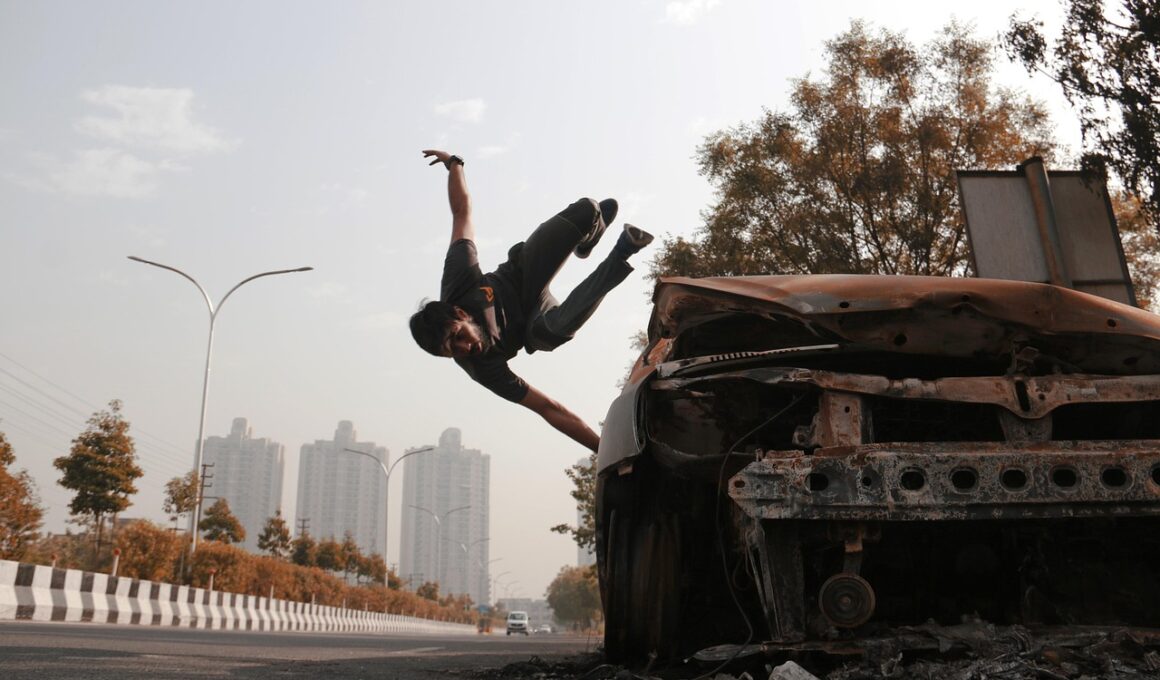Essential Warm-up Exercises to Prevent Landing Injuries
Parkour and freerunning are exciting physical activities that require a variety of techniques, including precise landing techniques, to ensure safety and effectiveness. One of the primary methods to prevent landing injuries is through a comprehensive warm-up routine. Incorporating essential warm-up exercises can prepare your body for the demands of parkour, enabling you to minimize injury risks during practice and execution of tricks. Start with dynamic stretching to increase blood flow to muscles, which helps improve overall flexibility and mobility. Engage in exercises that target the ankles, knees, and hips, as these joints are crucial for absorbing landing impacts. Jumping jacks, leg swings, and lunges can be effective, but consider also including specific moves tailored to landing techniques. Proper warm-up prepares your body for the most strenuous activities and keeps your muscle tissue healthy for the challenges ahead. In this article, we will discuss several essential warm-up exercises that focus on enhancing strength, flexibility, and coordination. These exercises are designed for both beginners and experienced practitioners, making them perfect for anyone looking to advance their parkour skills while preventing injuries. Be sure to implement them regularly into your training.
The effectiveness of a warm-up routine is greatly enhanced when recognizing the importance of gradual progression in difficulty and intensity. Starting with low-impact exercises is crucial, as it allows you to ease into your workout while warming up your muscles adequately. Dynamic stretches should not only focus on each muscle group involved but should encourage functional movement patterns that mimic the actions within parkour. For instance, incorporate movements like bear crawls and high knees to engage the core and improve overall body awareness. Besides dynamic stretches, stability exercises are beneficial for building strength in your joints and ensuring better control over your landings. Balance exercises like single-leg stands or controlled squats help train those small stabilizer muscles. This foundational strength is key in reducing the potential for sprains or injuries when landing on uneven surfaces or varying heights. Always pay attention to your body’s signals during warm-ups; if you encounter any tightness or discomfort, it may signal the need for additional stretching in those areas. An attentive, gradual approach assists in preparing your body in a safe manner, optimizing your training sessions moving forward.
Lower Body Warm-up Exercises
Warm-up exercises that specifically target the lower body serve crucial roles in safeguarding your knees, ankles, and hips while executing landings in parkour. Ankle circles are simple yet effective; they involve rotating your foot in both directions to enhance mobility and flexibility around the joint. Following this, practice calf raises to strengthen the calf muscles, which play a significant part in shock absorption during landings. Move on to lunges, focusing on both forward and backward variations to activate the quadriceps, hamstrings, and glutes. Consider incorporating dynamic exercises like ‘butt kicks’ or ‘high knees’ to elevate heart rate further while loosening leg muscles. Incorporating leg swings will help open the hip joints, essential for executing broad, stable landings. Focusing on hip mobility, try lateral lunges, and other hip-opening exercises that improve stability during movement. Another beneficial exercise is the ‘lying leg raises,’ targeting the lower abs along with hip flexors. Control your movements and pay attention to form; this precise focus prepares your body, thus minimizing potential injuries when practicing various parkour landing techniques.
Range-of-motion drills can complement traditional warm-up exercises greatly. Targeting the very tissues that absorb impact when landing, these drills are designed to increase flexibility and diminish stiffness in key areas. Start with an easy-to-perform ‘wrist stretch’ to ensure that your arms are also prepared for impact, especially when rolling or falling in parkour. You can also integrate controlled toe touches to promote improved flexibility in your lower back and hamstrings. Engaging in hip circles helps activate the hip joints further. For improved muscle activation and engagement, try ‘dynamic stretching of the lower back’ while standing. Maintain a balanced approach by alternating a variety of stretches and movements to create an overall functional warm-up routine. As you incorporate these exercises into your preparation, monitor your progress to see improvements in flexibility over time; this, in turn, can enhance your landing abilities. Ultimately, the goal of an effective warm-up routine is to equip your body to handle intense activations, ensuring higher chances of success. Make this part of your training approach to not only advance skills but also maintain good health.
Strength and Conditioning Elements
Incorporating strength and conditioning elements within your warm-up routine bolsters your overall performance in parkour. Building upper body strength helps in better landings, momentum management, and executing various techniques. One effective exercise is the push-up, which strengthens your chest, triceps, and shoulders. As you gain strength in these areas, you will notice enhanced control over your body during landings and rolls. You can also perform plank variations to build core strength, which is foundational in maintaining balance and stability upon landing. A stable core significantly reduces the risk of injury during complex movements. Incorporating body-weight exercises such as squats and single-leg deadlifts into your warm-up can fortify your lower body while introducing coordination challenges. Gradually increase the complexity or intensity of these exercises, allowing your body to adapt and grow stronger over time. As strength training increases, so will your muscle endurance, crucial for longer practice sessions. A well-structured warm-up that addresses strength and conditioning can maximize your skill set and effectiveness in parkour, enabling you to take on higher challenges safely.
The mental aspect of warming up often goes overlooked but is equally important. Visualization techniques can enhance your muscle memory before executing complex parkour maneuvers, which include how to land safely. Focusing mentally on each movement during your warm-up creates neural pathways that improve coordination, balance, and stability during actual parkour sessions. Think of how a dancer prepares mentally for her performance; similarly, parkour practitioners can utilize mental imagery to reinforce confidence. Additionally, integrating deep-breathing exercises during warm-ups can help calm your mind and prepare you mentally. Simple techniques, such as inhaling deeply while stretching and exhaling upon releasing, can help create a focused mindset. Such practices allow for better execution of landing techniques and prepare you to react swiftly and correctly. By combining mental preparation with physical exercises, you will find your overall performance enhancing significantly. Studies have shown that athletes perform better when they are mentally prepared. Addressing mental preparedness during the warm-up is essential not only for preventing injuries but also enhancing performance, leading to striking improvements in your parkour skills.
Cool Down and Stretching Practices
Equally important to a warm-up routine is the cool down and follow-up stretching practice. After an intense training session, incorporating static stretches helps improve flexibility and reduces muscle soreness. Additionally, cool down routines can significantly facilitate recovery while promoting relaxation post-training. Focus on the major muscle groups worked during your session, which include quads, hamstrings, shoulders, and back. An example of an effective cooldown stretch is the seated forward bend, which targets the hamstrings and lower back. Simple static stretches held for 20-30 seconds can bring the heart rate down gently and provide restoration. Add in a few deep breathing techniques to enhance relaxation during your cooldown—the exhale encouraging a deeper stretch. This extends well into your cooling routine. Ensure you dedicate specific time for cooldown activities; doing this on every training day can profoundly affect how you feel the following day. Consistently applying both warm-up and cooldown routines in your training regimen is crucial for safety and overall health in the practice of parkour.
In conclusion, warm-up exercises are essential for anyone practicing parkour or freerunning. By implementing a structured and diverse warm-up routine, practitioners can effectively minimize the risk of landing injuries and enhance their overall performance. Pay attention to the elements of strength, inclusivity of techniques focusing on lower body mobility, and the importance of maintaining mental focus during your sessions. Regularly practicing these warm-up techniques not only promotes a healthier approach to physical activity but also strengthens your skills and confidence while performing parkour maneuvers. Encourage fellow practitioners to adopt these practices and foster a community that prioritizes safety and preparedness through a well-rounded warm-up routine. Ultimately, every parkour enthusiast should recognize the value of proper warm-ups and cooldowns in their training, not just as a preliminary task but as an essential foundation for progress. Embrace the journey of developing skills while minimizing potential setbacks, and continue to explore the thrill of parkour and freerunning with a focus on safety and well-being. Make every practice a step towards mastering the landings with confidence.


